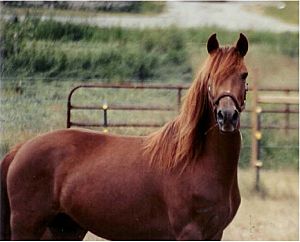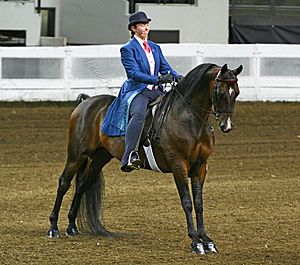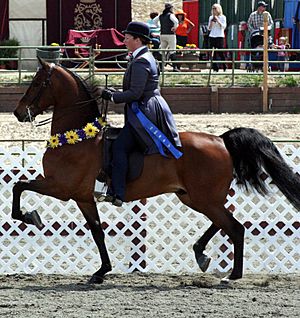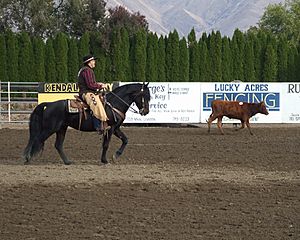Morgan horse facts for kids

A Morgan horse
|
|
| Distinguishing features | Compact, muscular but refined build, expressive head, well arched neck. |
|---|---|
| Country of origin | United States |
| Breed standards | |
| American Morgan Horse Association | Breed standards |
| Horse (Equus ferus caballus) | |
The Morgan horse is one of the oldest horse breeds from the United States. All Morgans can trace their family tree back to one special horse named Figure. He was later called Justin Morgan after his most famous owner.
In the 1800s, Morgans were used for many jobs. They pulled coaches and raced in harness racing. They were also good riding horses and served as cavalry horses in the American Civil War. Morgans helped create other American horse breeds, like the American Quarter Horse and the Tennessee Walking Horse.
Over time, Morgans were sent to other countries, including England. In 1907, the US Department of Agriculture started the University of Vermont Morgan Horse Farm in Vermont. This farm helped keep the Morgan breed strong and healthy. The first official group for the breed was created in 1909. Today, there are over 175,000 Morgan horses around the world.
Morgans are strong and elegant horses. They are usually bay, black, or chestnut in color. But they can also come in many other colors, including some pinto patterns. People use Morgans for both English and Western riding styles. They are known for being very good at many different things. The Morgan is the official state animal of Vermont and the state horse of Massachusetts and Rhode Island. Famous children's authors, like Marguerite Henry, have written books about these amazing horses.
Contents
What Makes a Morgan Horse Special?
There is one official standard for what a Morgan horse should look like. Morgans are strong and well-built. They have powerful legs and an expressive head. Their eyes are large, and their neck is well-arched. They have a short back and strong hindquarters. Their tail is set high and carried gracefully.
Morgans look very powerful and are known as "easy keepers." This means they don't need a lot of special care to stay healthy. Most Morgans are between 14.1 and 15.2 hands tall. Some might be a bit taller or shorter.
How Morgans Move
Morgans have a lively and smooth trot. Their front and back legs move in a balanced way. Some Morgans can also do other special gaits, like the rack or pace. The United States Equestrian Federation says Morgans are known for their "stamina and vigor." They are also known for being smart, brave, and having a good personality.
Morgan Horse Colors
Morgans come in many colors. The most common colors are bay, black, and chestnut. Less common colors include gray, roan, dun, and silver dapple. They can also have cream colors like palomino and buckskin. Three types of pinto patterns are also seen in Morgans: sabino, frame overo, and splashed white.
Morgan Horse Health
Like some other breeds, Morgans can have a genetic muscle condition called Type 1 polysaccharide storage myopathy. However, it is not very common in Morgans.
Some coat color genes in Morgans are also linked to health issues. The silver dapple gene can cause a mild eye condition called MCOA. This condition usually doesn't cause serious vision problems. Also, the frame overo gene can cause a fatal condition called lethal white syndrome in foals if they inherit two copies of the gene. Horse groups suggest genetic testing to help breeders avoid these issues.
The History of the Morgan Horse
Justin Morgan: The First Morgan Horse
All Morgan horses come from one special stallion named Figure. He was born in 1789 in Massachusetts. In 1792, he was given to a man named Justin Morgan as payment for a debt. People started calling the horse "the Justin Morgan horse," and that's how the breed got its name.
Figure was about 14 hands tall and weighed about 1,000 pounds. He was famous for passing on his unique looks, strong body, good temper, and athletic skills to his foals. We don't know exactly who Figure's parents were, even though many people have tried to find out. Figure died in 1821 after being kicked by another horse. He was buried in Vermont.
Figure had many foals, but only six of his sons are well-known. Three of them became important for starting the Morgan breed.
- Woodbury was a chestnut horse who stood 14.3 hands tall. He was a popular breeding stallion in New England.
- Bulrush was a dark bay horse, the same size as Figure. He was known for his amazing endurance and speed in racing.
- Sherman was another chestnut stallion, a bit shorter than Figure. Sherman's son, Black Hawk, became a key horse for other breeds like the Standardbred. Black Hawk was famous for winning all his harness races. Black Hawk's son, Ethan Allen, was also very important to the Morgan breed and known for his speed.
How the Breed Grew
In the 1800s, Morgans were valued for being useful horses. They were great for harness racing and pulling coaches because they were fast and had a lot of stamina. They also worked as stock horses and were good for general riding. Miners used them during the California Gold Rush. The Army also used Morgans during and after the American Civil War.
A Morgan stallion named Shepherd F. Knapp was sent to England in the 1860s. His trotting skills helped develop the Hackney horse breed there. Many Morgan mares were also taken west, which influenced the American Quarter Horse breed. By the 1870s, people started wanting taller horses. Morgans were sometimes crossed with other breeds, and the original Morgan type almost disappeared. But a few remained in quiet areas.
In 1894, Colonel Joseph Battell published the first official book of Morgan horses. This was the start of the formal breed registry. In 1907, the United States Department of Agriculture opened the US Morgan Horse Farm in Vermont. Their goal was to keep the Morgan breed strong and improve it. The farm wanted to produce horses that were healthy, well-behaved, and good at both riding and pulling. In 1951, the farm was given to the University of Vermont, which continues the program today.
Morgans in the Military
Morgans were used as cavalry horses by both sides in the American Civil War. For example, Sheridan's famous horse, Winchester, was a descendant of Black Hawk. There's a story that Stonewall Jackson's horse, "Little Sorrel," might have been a Morgan.
Some people also believe that Comanche, the only horse to survive Custer's regiment at the Battle of the Little Bighorn, was a Morgan or a Morgan mix. However, army records suggest Comanche was more likely a Mustang or a mix of "American" and "Spanish" horses from the Oklahoma or Texas area.
Morgan Horse Families
Today, there are four main groups of Morgan horses, often called "families." These are the Brunk, Government, Lippitt, and Western Working families. There are also smaller groups.
- The Brunk Family is known for being strong and athletic.
- The Lippitt Family is considered the "purest" line. These horses have the most direct links back to Figure and have not been mixed with other breeds in recent times.
- The Government Family is the largest group. These Morgans come from the horses bred at the US Morgan Horse Farm between 1905 and 1951. The University of Vermont continues this breeding program today.
- The Working Western Family includes Morgans bred to be stock horses and work with cattle.
Morgan Horse Groups
In 1909, the Morgan Horse Club was started. It later became the American Morgan Horse Association (AMHA). In 1948, the AMHA decided to "close" its stud book. This means that only horses with Morgan parents can be registered as Morgans.
The AMHA is the largest group for the breed. As of 2012, about 179,000 Morgans have been registered. Over 3,000 new foals are registered every year. Morgans are most popular in the United States, but they also live in Great Britain, Sweden, and other countries.
Besides the AMHA, there are other groups for Morgans:
- The National Morgan Pony Registry is for Morgans under 14.2 hands tall.
- The Rainbow Morgan Horse Association works with the AMHA to promote Morgans with unusual colors.
- The Foundation Morgan Horse Association registers Morgans that look like the older, stockier type from the 1800s.
- The Lippitt Club and the Lippitt Morgan Breeders Association work to preserve the "Lippitt" strain of Morgans.
- There are also Morgan horse groups in Canada, Australia, New Zealand, and other countries.
- In Middlebury, Vermont, there is a museum all about the history of the Morgan horse.
What Morgans Are Used For
Morgan horses are famous for being able to do many different things. People use them for many English and Western events. They are good at dressage, show jumping, Western pleasure, and endurance riding. They also work as stock horses and are popular for pleasure riding and driving competitions. Morgans were the first American breed to compete in the World Pairs Driving competition.
Because they are gentle and move smoothly, Morgans are often used in programs like 4-H and Pony Club. They are also great for therapeutic riding programs, helping people with special needs.
There are special Morgan-only horse shows held across the US. The first big show, the Grand National and World Championship Morgan Horse Show, was held in 1973. Now, over 1,000 horses compete there each year.
In 1961, the Morgan horse became the official state animal of Vermont. In 1970, it became the official state horse of Massachusetts.
Morgans in Books and Movies
The children's book Justin Morgan Had a Horse by Marguerite Henry was published in 1945. It tells a fictional story about Figure and Justin Morgan. A Disney movie based on the book was made in 1972. While these are fun stories, they do have some historical mistakes.
Ellen Feld, another children's author, has a popular "Morgan Horse" book series. Her book Blackjack: Dreaming of a Morgan Horse won an award in 2005.
The famous poet Robert Frost wrote a poem called The Runaway about a Morgan horse. In the poem, he describes a young Morgan colt who seems scared of the snow in a mountain pasture.
- Mellin, Jeanne (1986), The Complete Morgan Horse, S. Greene Press (Viking/Penguin Imprint), ISBN: 0828905908
- Morgan, W. Robert (1987), The Morgan Horse of the West, Vantage Press, ISBN: 0533071100
- Spencer, Sally (1994), The Morgan Horse, J.A. Allen, ISBN: 0851315992
See also
 In Spanish: Morgan (caballo) para niños
In Spanish: Morgan (caballo) para niños







